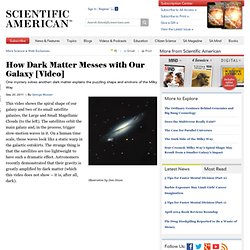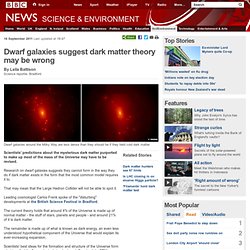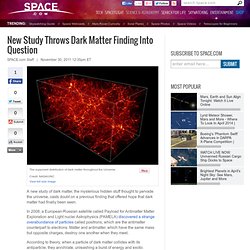

Dark matter. Astronomers reach new frontiers of dark matter. Astronomers have mapped dark matter on the largest scale ever observed.

The School's Dr Catherine Heymans and Associate Professor Ludovic Van Waerbeke of the University of British Columbia, Vancouver, Canada, will present the results today to the American Astronomical Society meeting in Austin, Texas. Their findings reveal a Universe comprising an intricate cosmic web of dark matter and galaxies spanning more than one billion light years. An international team of researchers lead by Van Waerbeke and Heymans achieved their results by analysing images of about 10 million galaxies in four different regions of the sky. Monster Galaxy Cluster 'El Gordo' Packs Mass of 2 Quadrillion Suns. AUSTIN, Texas — The largest cluster of galaxies seen yet in the early universe, a giant that astronomers have dubbed "El Gordo," could one day reveal secrets about the invisible dark matter that fills the universe, researchers said.

El Gordo — which means "the fat one" in Spanish — is officially known as ACT-CL J0102-4915 and "is located more than 7 billion light-years from Earth, at a time when the universe was half its current age," study co-author John Patrick Hughes at Rutgers University told SPACE.com. The universe is about 13.7 billion years old.
The monster galaxy cluster has mass about 2 quadrillion (that's 2 followed by 15 zeroes) times that of the sun, making it "the most massive known cluster in the distant universe. " Could primordial black holes be dark matter? (PhysOrg.com) -- “We know that about 25% of the matter in the universe is dark matter, but we don’t know what it is,” Michael Kesden tells PhysOrg.com.

“There are a number of different theories about what dark matter could be, but we think one alternative might be very small primordial black holes.” When many of us think about black holes, we think of a huge cosmic event, sucking in everything around it. However, there is also the possibility of small black holes. “Einstein’s theory of relativity allows for black holes,” Kesden, a theoretical physicist at New York University, explains, “but doesn’t stipulate a size. It’s very possible that the early universe produced very small black holes. Kesden worked with Shravan Hanasoge, from Princeton University and the Max Planck Institute for Solar System Research, to work out method of using solar oscillations to determine whether a small, primordial black hole passed through a star. How Dark Matter Messes with Our Galaxy. This video shows the spiral shape of our galaxy and two of its small satellite galaxies, the Large and Small Magellanic Clouds (to the left).

The satellites orbit the main galaxy and, in the process, trigger slow-motion waves in it. On a human time scale, those waves look like a static warp in the galactic outskirts. The strange thing is that the satellites are too lightweight to have such a dramatic effect. Astronomers recently demonstrated that their gravity is greatly amplified by dark matter (which this video does not show -- it is, after all, dark).
Black hole, star collisions may illuminate universe's dark side. Scientists looking to capture evidence of dark matter -- the invisible substance thought to constitute much of the universe -- may find a helpful tool in the recent work of researchers from Princeton University and New York University.

The team unveiled in a report in the journal Physical Review Letters this month a ready-made method for detecting the collision of stars with an elusive type of black hole that is on the short list of objects believed to make up dark matter. Such a discovery could serve as observable proof of dark matter and provide a much deeper understanding of the universe's inner workings. Postdoctoral researchers Shravan Hanasoge of Princeton's Department of Geosciences and Michael Kesden of NYU's Center for Cosmology and Particle Physics simulated the visible result of a primordial black hole passing through a star. "If you imagine poking a water balloon and watching the water ripple inside, that's similar to how a star's surface appears," Kesden said. Dwarf galaxies suggest dark matter theory may be wrong. 16 September 2011Last updated at 18:47 By Leila Battison Science reporter, Bradford Dwarf galaxies around the Milky Way are less dense than they should be if they held cold dark matter Scientists' predictions about the mysterious dark matter purported to make up most of the mass of the Universe may have to be revised.

Research on dwarf galaxies suggests they cannot form in the way they do if dark matter exists in the form that the most common model requires it to. That may mean that the Large Hadron Collider will not be able to spot it. Leading cosmologist Carlos Frenk spoke of the "disturbing" developments at the British Science Festival in Bradford. "Dark-Matter" Sagittarius Galaxy Smashed into the Milky Way Twice - Creating Outer Spiral Arms.
A dwarf galaxy named Sagittarius loaded with dark matter has careened twice through our much larger home galaxy in the past two billion years, according to telescope data and detailed simulations, and is poised to strike the southern face of the Milky Way disk in another 10 million years or so.

Many astronomers believe that the large galaxies seen today were formed from smaller "dwarf" galaxies, which formed first after the Big Bang. Many of these dwarfs either clumped together to form larger galaxies or were gradually swallowed up by larger galaxies that continued to grow by "cannibalizing" smaller ones. It's the weighty dark matter from Sagittarius that provided the initial push, the researchers said. "It's kind of like putting a fist into a bathtub of water as opposed to your little finger," said James Bullock, a theoretical cosmologist who studies galaxy formation. Milky Way Arm Wrestles With Dark Matter. Want to stay on top of all the space news?

Follow @universetoday on Twitter Computer model of the Milky Way and its smaller neighbor, the Sagittarius dwarf galaxy. The flat disk is the Milky Way, and the looping stream of material is made of stars torn from Sagittarius as a result of the strong gravity of our galaxy. The spiral arms began to emerge about two billion years ago, when the Sagittarius galaxy first collided with the Milky Way disk. Image by Tollerud, Purcell and Bullock/UC Irvine. New Study Throws Dark Matter Finding Into Question.
A new study of dark matter, the mysterious hidden stuff thought to pervade the universe, casts doubt on a previous finding that offered hope that dark matter had finally been seen.

In 2008, a European-Russian satellite called Payload for Antimatter Matter Exploration and Light nuclei Astrophysics (PAMELA) discovered a strange overabundance of particles called positrons, which are the antimatter counterpart to electrons. Matter and antimatter, which have the same mass but opposite charges, destroy one another when they meet. According to theory, when a particle of dark matter collides with its antiparticle, they annihilate, unleashing a burst of energy and exotic particles. Search for Elusive Dark Matter May Get Boost From New Galaxies. Astronomers have found two small galaxies that appear to circle our Milky Way's galactic neighbor Andromeda, and could shed new light on the mystery of dark matter in the universe, scientists say.

The newfound dwarf galaxies, called Andromeda 28 and 29, are two of the most distant satellites galaxies from Andromeda ever detected. They are located about 600,000 light-years away from Andromeda, and approximately 1.1 million light-years from Earth, researchers said. The Andromeda galaxy is about 2.5 million light-years away and is the nearest spiral galaxy to the Milky Way. Like our galaxy, Andromeda is surrounded by numerous dwarf satellite galaxies. These newly found dwarf galaxies were discovered using a star-counting technique on the newest data from the Sloan Digital Sky Survey, which has mapped more than a third of the night sky. One step closer to dark matter in universe. Scientists all over the world are working feverishly to find the dark matter in the universe. Now researchers at Stockholm University have taken one step closer to solving the enigma with a new method. The universe is still a mystery. We know what about 5 percent of the universe consists of.
The rest is simply unknown. Researchers have gotten as far as knowing that a major portion, about 23 percent of the universe consists of a new kind of matter. "With our new method, for the first time we have been able to exclude models regarded by many as the most natural ones. Dark Matter: Now More Mysterious Than Ever. Astronomers have one more reason to scratch their heads over the unseen material known as dark matter. Observations of two dwarf galaxies, Fornax and Sculptor, show the dark matter within them is spread out smoothly rather than heaped into a central bulge, contradicting cosmological models. Dark Matter Mystery Deepens. Like all galaxies, our Milky Way is home to a strange substance called dark matter. Dark matter is invisible, betraying its presence only through its gravitational pull. Without dark matter holding them together, our galaxy’s speedy stars would fly off in all directions.
Hubble survey carries out a dark matter census. Cluster MACS J1206.2-0847 (or MACS 1206 for short) is one of the first targets in a Hubble survey that will allow astronomers to construct the highly detailed dark matter maps of more galaxy clusters than ever before. These maps are being used to test previous but surprising results that suggest that dark matter is more densely packed inside clusters than some models predict.
This might mean that galaxy cluster assembly began earlier than commonly thought. The Cluster Lensing And Supernova survey with Hubble (CLASH) probes, with unparalleled precision, the distribution of dark matter in 25 massive clusters of galaxies. So far, the CLASH team has observed six of the 25 clusters. Astronomers reach new frontiers of dark matter. Dark matter mysteries: a true game of shadows. By Stuart Clark Editorial: “No more eureka moments“ IT’S a troubling time to be looking for the universe’s missing matter. Blow for 'dark matter' theory as scientists find faint, undetected star. Tiny, faint star has mass one-fifth of our SunUndetected stars could make up bulk of star clustersBlow for theory that 'dark matter' accounts for much of universe's mass By Rob Waugh Updated: 18:56 GMT, 22 December 2011.
What Higgs result means for dark matter conspiracy. RECENT hints of a featherweight Higgs boson don't just take us nearer to a complete standard model of physics. NASA satellite could reveal if primordial black holes are dark matter. (PhysOrg.com) -- The primary objective of NASA’s Kepler satellite, which was launched in March 2009 to orbit the Sun, is to search for Earth-like planets in a portion of the Milky Way galaxy. Latest Fermi studies find no trace of dark matter. A Second Dish of Dark Matter. Physicists suggest possible existence of other kinds of dark matter. (Phys.org) —A team of Harvard University physicists has proposed the possible existence of a type of dark matter not described by current physics models. In their paper published in the journal Physical Review Letters, the team suggests it's possible that not all dark matter is cold and collision-less. In the visible universe, galaxies form into a disk shape—the Milky Way is a good example. All of its members align roughly along a single plane, this due to the forces of gravity and spin.
Dark matter, apparently, is midichlorians. Dark matter, to re-interpret Obi Wan Kenobi, surrounds us and penetrates us. It binds the galaxy together. Missing dark matter located: Intergalactic space is filled with dark matter. Dark Matter Core Defies Explanation in NASA Hubble Image. Nearby Dark Matter Mysteriouly Missing. Dark Matter Found Lurking at Edges of Galaxies. Repulsive gravity as an alternative to dark energy (Part 2: In the quantum vacuum) Early Universe May Have Abounded With Dark Matter-Powered Stars. Repulsive gravity as an alternative to dark energy (Part 1: In voids) Strange Dark Matter Interactions Could Create Galactic Disks and Dark Light. Dark Matter May Collide With Atoms Inside You More Often Than Thought. New Study Finds Vast Galactic Network, No Sign of Dark Matter. Dark matter mysteries: a true game of shadows. Dark matter filament studied in 3-D for the first time.